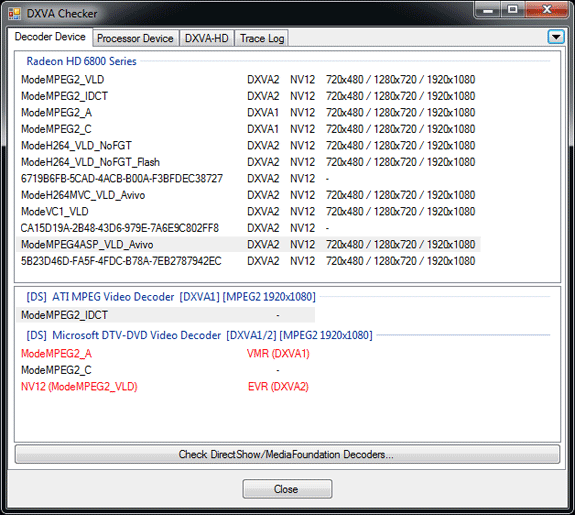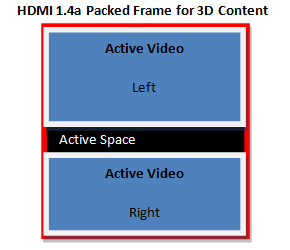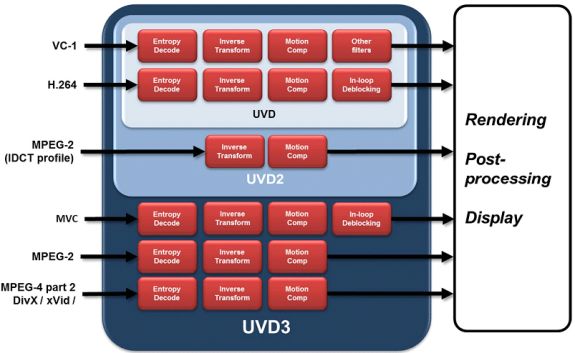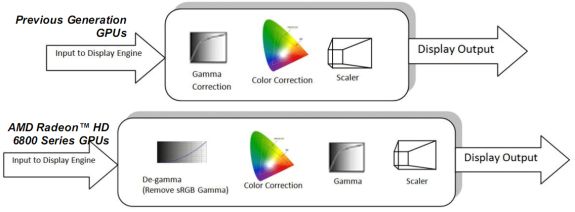AMD’s Radeon HD 6870 & 6850: Renewing Competition in the Mid-Range Market
by Ryan Smith on October 21, 2010 10:08 PM ESTSeeing the Present: HDMI 1.4a, UVD3, and Display Correction
DisplayPort wasn’t the only aspect of AMD’s display controller that got an overhaul however, AMD’s HDMI capabilities have also been brought up to modern standards. Coming from Cypress with support for HDMI 1.3, AMD now supports HDMI 1.4a on the Barts based 6800 series and presumably they will do so on the rest of the 6800 series too. With HDMI 1.4a support AMD can now support full resolution (1080p) 3D stereoscopy for movies, and 720p for games and other material that require 60Hz/eye, along with 4k x 2k resolution for monitors and TVs that have equivalent support. Unlike DP this has less to do with monitors and more to do with TVs, so the importance of this will be seen more on future AMD cards when AMD refreshes their lower-end parts that we normally use with HTPCs.
Launching alongside support for displaying full resolution 3D stereoscopic video is the hardware necessary to decode such video, in the form of the latest version of AMD’s Unified Video Decoder: UVD3. The last time UVD received a major update was with UVD2, which launched alongside the Radeon HD 4000 series and added partial MPEG-2 decoding support by moving IDCT and MoComp from shaders in to the UVD fixed function hardware.
With the Radeon 6800 series AMD is releasing UVD3, which like UVD2 before it builds on the existing UVD feature set. UVD3 is adding support for 3 more-or-less new codecs: MPEG-2, MVC, and MPEG-4 ASP (better known as DivX/XviD). Starting with MPEG-4 ASP, it’s the only new codec in supported by UVD3 that’s actually new, as previously all MPEG-4 ASP decoding was done in software when it came to AMD GPUs. With UVD3 AMD can now completely offload MPEG-4 ASP decoding to the GPU, bringing forth the usual advantages of greatly reducing the amount of work the CPU needs to do and ideally reducing power consumption in the process.
AMD adding MPEG-4 ASP support gives us an interesting chance to compare and contrast them to NVIDIA, who added similar support a year ago in the GT21x GPUs. AMD is a good bit behind NVIDIA here, but they’re making up for it by launching with much better software support for this feature than NVIDIA did; NVIDIA still does not expose their MPEG-4 ASP decoder in most situations, and overall did a poor job of advertising it. When we talked with DivX (who is AMD’s launch partner for this feature) they didn’t even know that NVIDIA had MPEG-4 ASP support. Meanwhile AMD is launching with DivX and had a beta version of the DivX codec with UVD3 support ready to test, and furthermore AMD is fully exposing their MPEG-4 ASP capabilities in their drivers as we see in this DXVA Checker screenshot.

The only downside at this time is that even with Microsoft’s greater focus on codecs for Windows 7, Windows 7 doesn’t know what to do with DXVA acceleration of MPEG-4 ASP. So while Win7 can play MPEG-4 ASP in software, you’re still going to need a 3rd party codec like the DivX codec to get hardware support for MPEG-4 ASP.
The other bit worth mentioning is that while AMD is launching support for MPEG-4 ASP decoding here on the 6800 series, much like HDMI 1.4a it’s not going to be a big deal for the 6800 series market. MPEG-4 ASP is a fairly lightweight codec, so support for it is going to be a bigger deal on low-end products, particularly AMD’s APUs if Llano and Bobcat end up using UVD3, as MPEG-4 ASP decoding in software requires a much greater share of resources on those products.
Up next is MPEG-2, which has been a codec stuck in limbo for quite some time over at AMD. MPEG-2 is even older and easier to decode than MPEG-4 ASP, and while GPUs have supported MPEG-2 decode acceleration as early as last decade, CPUs quickly became fast enough that when combined with low levels of hardware decode acceleration (inverse discrete cosine transform) was more than enough to play MPEG-2 content. Thus AMD hasn’t done much with MPEG-2 over the years other than moving IDCT/MoComp from the shaders to UVD for UVD2.
Because of the similarities between MPEG-4 ASP and MPEG-2, when AMD added support for full MPEG-4 ASP decode acceleration they were able to easily add support for full MPEG-2 decode acceleration, as they were able to reuse the MPEG-4 ASP entropy decode block for MPEG-2. As a result of including full MPEG-4 ASP decode acceleration, AMD now supports full MPEG-2 decode acceleration. Even more so than MPEG-4 ASP however, the benefits for this are going to lie with AMD’s low-end products where getting MPEG-2 off of the CPU should be a boon for battery life.

The final addition to UVD3 is support for Multiview Video Coding, which isn’t a new codec per se, but rather is an extension to H.264 for 3D stereoscopy. H.264 needed to be amended to support the packed frame formats used to store and transmit 3D stereoscopic videos, so with UVD3 AMD is adding support for MVC so that UVD can handle Blu-Ray 3D.
Finally, coupled with support for new codecs and new display outputs in AMD’s display controller is a refinement of AMD’s existing color correction capabilities in their display controller. Cypress and the rest of the 5000 series could do color correction directly on their display controllers, but they could only do so after gamma correction was applied, meaning they had to work in the non-linear gamma color space. Technically speaking this worked, but color accuracy suffered as a result. With the 6800 series’ new display controller, AMD can now perform color calibration in linear space by converting the image from gamma to linear color space for the color correction, before converting it back to gamma color space for display purposes.
As color correction is being used to correct for wide-gamut monitors the importance of this change won’t be seen right away for most users, but as wide-gamut monitors become more widespread color correction becomes increasingly important since wide-gamut monitors will misinterpret the normal sRGB colorspace that most rendering is done in.












197 Comments
View All Comments
GullLars - Saturday, October 23, 2010 - link
One sollution would be to to move away from pure number based naming, and do something like:AMD/nVidia AG#S# ([Maker]_[Architecture][Generation][# generation of architecture][Market Segment][# of relative performance within segment 1-9]
Or possibly AMD/Nvidia Architecture Gen# S#
Example:
AMD EG1E9 or Evergreen Gen1 E9 = 5970 (Enthusiast)
nVidia FG1E9 = 480
AMD Evergreen Gen2 G5(?) = 6850 (Gamer)
AMD Evergreen Gen1 V7 = 5770 (Value)
AMD Evergreen Gen1 M5 = 5350 (Media)
These are just early floating thoughts, which could be refined by marketing monkeys.
Exelius - Saturday, October 23, 2010 - link
Marketing monkeys have no intent on making it simple to understand; if you don't know exactly what you're buying, it's easier to sell it to you for more than they would be able to otherwise.It's not an accident that the numbering is confusing; if you don't know what you're looking at then a 6870 at a lower price than a 5870 looks like a great deal.
MonkeyPaw - Friday, October 22, 2010 - link
Big deal, I say. The card is a few % slower, but is more efficient and is cheaper. People who will actually notice the drop off will probably read reviews first. Besides, if the x900 series is for dual GPU designs, then the naming might not be far off.Also, if I had to pick between the 5800 or the 6800, I'd probably get a 6800.
therealnickdanger - Friday, October 22, 2010 - link
Don't forget improved image quality!It's only disappointing because with a new moniker, I expect new tech, but then again, how long did NVIDIA push G92? 3 generations as different products? LOL
Rafterman - Friday, October 22, 2010 - link
What exactly have NVidia got to do with this, no fanboyism please.morphologia - Friday, October 22, 2010 - link
They are a comparable company with comparably ridiculous naming conventions. How do you go from 9000 to 200?Talk about fanboyism...claiming irrelevancy when it's totally relevant reveals your fanboy decoder ring quite clearly.
Alilsneaky - Friday, October 22, 2010 - link
I hated nvidia for doing it, why should amd now be forgiven for resorting to doing the same bullshit just because nvidia did it before them?I had someone tell me earlier 'that's business'.
WHAT? No it's bloody not, a scam is a scam, when people start equalling questionable practices like these to business then something is really wrong with today's society.
Mr Perfect - Friday, October 22, 2010 - link
What Nvidia did was simply rename the 8800 cards to 9800 card. Same exact chip, same exact clocks, same exact board(at least initially). There where owners of 8800GTs who simply edited the name in the BIOS of their card and had a 9800GT!The reason AMD is getting a pass from most people is because this isn't a purely renamed card. It's a redesigned chip on a new PCB with a poor name. If, on the other hand, AMD renames the 5750 and 5770 to the 6750 and 6770 you can expect them to get nailed to the wall right next to Nvidia.
pcfxer - Saturday, October 23, 2010 - link
It was very clear why he mentioned NVIDIA. You should read his post...snarfbot - Friday, October 22, 2010 - link
at least all the iterations of g92 improved performance over their predecessor.compare this launch to the x1xxx series of ati products, the x1800 was replaced by the x1900 which was replaced by the x1950. all of which improved performance over their predecessor. all the while on the same process 90nm.(save for the 1950pro and gt, which were mainstream parts.)
imagine if they named the x1900 the x2900, and somehow it actually performed worse than the x1800.
thats what they did here, and thats why it fails imo.
if they just called it hd5790 and kept it at the same price people wouldve gobbled it up anyway, without sacrificing their integrity.
just a bunch of numbers, but what it means in mindshare is important, and all most people will remember about this generation, is that it was worse than the 5 series and worse than nvidias.
all aboard the fail boat. honk honk.